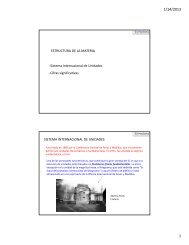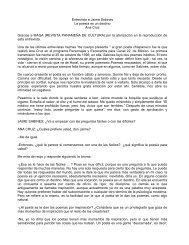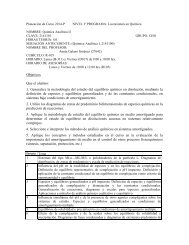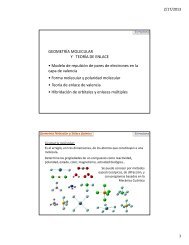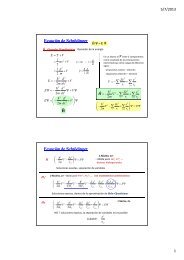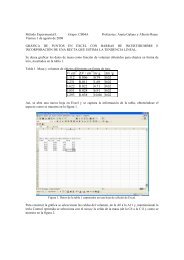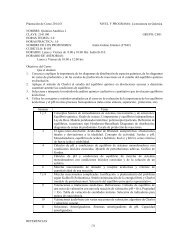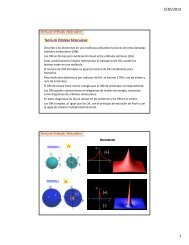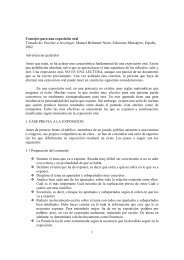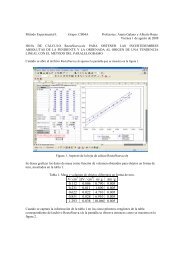Método de Hückel De los métodos de la Química Cuántica que se ...
Método de Hückel De los métodos de la Química Cuántica que se ...
Método de Hückel De los métodos de la Química Cuántica que se ...
You also want an ePaper? Increase the reach of your titles
YUMPU automatically turns print PDFs into web optimized ePapers that Google loves.
<strong>Química</strong> <strong>Cuántica</strong><br />
<strong>Método</strong> <strong>de</strong> <strong>Hückel</strong><br />
<strong>De</strong> <strong>los</strong> <strong>métodos</strong> <strong>de</strong> <strong>la</strong> <strong>Química</strong> <strong>Cuántica</strong> <strong>que</strong> <strong>se</strong> aplican al<br />
estudio <strong>de</strong> molécu<strong>la</strong>s orgánicas no saturadas, el <strong>de</strong> <strong>Hückel</strong> es<br />
el más popu<strong>la</strong>r.<br />
El éxito <strong>de</strong> este método <strong>se</strong> <strong>de</strong>be a su gran simplicidad, <strong>que</strong><br />
permite incluso hacer cálcu<strong>los</strong> a mano, cuando el número <strong>de</strong><br />
átomos es pe<strong>que</strong>ño.<br />
Es el método <strong>de</strong> aproximación más simple <strong>de</strong> <strong>la</strong> teoría <strong>de</strong><br />
orbitales molecu<strong>la</strong>res para sistemas p<strong>la</strong>nos insaturados .<br />
Se basa en <strong>la</strong> <strong>se</strong>paración σ-π :<br />
<strong>Método</strong> <strong>de</strong> <strong>Hückel</strong><br />
<strong>Química</strong> <strong>Cuántica</strong><br />
Diferencias entre <strong>los</strong> electrones σ y π:<br />
• Están localizados en diferentes regiones <strong>de</strong>l espacio. Los electrones σ en el<br />
p<strong>la</strong>no molecu<strong>la</strong>r, <strong>los</strong> electrones π por encima y por <strong>de</strong>bajo <strong>de</strong>l p<strong>la</strong>no<br />
molecu<strong>la</strong>r<br />
σ<br />
π<br />
Los orbitales π tienen un p<strong>la</strong>no nodal <strong>que</strong> coinci<strong>de</strong> con el p<strong>la</strong>no<br />
molecu<strong>la</strong>r por lo <strong>que</strong> <strong>la</strong> probabilidad <strong>de</strong> encontrar un electrón π en el<br />
p<strong>la</strong>no molecu<strong>la</strong>r es nu<strong>la</strong>, mientras <strong>que</strong> <strong>la</strong> <strong>de</strong>nsidad electrónica σ es<br />
máxima en el p<strong>la</strong>no molecu<strong>la</strong>r, <strong>de</strong> modo <strong>que</strong> <strong>los</strong> electrones σ y π<br />
pue<strong>de</strong>n consi<strong>de</strong>rar<strong>se</strong> espacialmente <strong>se</strong>parados.<br />
La <strong>de</strong>nsidad π <strong>de</strong>be afectar muy poco a <strong>la</strong> σ, mientras <strong>que</strong> el efecto<br />
<strong>de</strong> <strong>los</strong> electrones σ sobre <strong>los</strong> π es e<strong>se</strong>ncialmente apantal<strong>la</strong>r <strong>la</strong> carga<br />
nuclear (<strong>la</strong> nube σ <strong>se</strong> encuentra más cerca <strong>de</strong> <strong>los</strong> núcleos<br />
1
<strong>Método</strong> <strong>de</strong> <strong>Hückel</strong><br />
<strong>Química</strong> <strong>Cuántica</strong><br />
Diferencias entre <strong>los</strong> electrones σ y π:<br />
• Los electrones π están más débilmente en<strong>la</strong>zados y son más fácilmente<br />
po<strong>la</strong>rizables <strong>que</strong> <strong>los</strong> electrones σ<br />
Los electrones σ <strong>se</strong> encuentran más cerca <strong>de</strong> <strong>los</strong> núcleos, por lo <strong>que</strong> <strong>la</strong><br />
interacción núcleo-electrón es más fuerte, ∴ <strong>los</strong> en<strong>la</strong>ces σ son más<br />
fuertes <strong>que</strong> <strong>los</strong> π:<br />
Hace falta más energía para romper un en<strong>la</strong>ce σ <strong>que</strong> para romper un<br />
en<strong>la</strong>ce π<br />
Es posible arrancar o añadir uno o dos electrones π en un sistema<br />
aromático y obtener iones re<strong>la</strong>tivamente estables (añadir electrones a<br />
orbitales antien<strong>la</strong>zantes π o substraer electrones <strong>de</strong> orbitales en<strong>la</strong>zantes<br />
π sin <strong>que</strong> <strong>la</strong> molécu<strong>la</strong> en cuestión <strong>se</strong> <strong>de</strong><strong>se</strong>stabilice consi<strong>de</strong>rablemente)<br />
Exitaciones electrónicas a OM π* no afectan <strong>se</strong>nsiblemente <strong>la</strong> estabilidad<br />
<strong>de</strong>l sistema, mientras <strong>que</strong> a OM σ* generalmente conllevan a <strong>la</strong><br />
disociación molecu<strong>la</strong>r<br />
Los electrones π pue<strong>de</strong>n consi<strong>de</strong>rar<strong>se</strong> químicamente más<br />
accesibles<br />
<strong>Método</strong> <strong>de</strong> <strong>Hückel</strong><br />
<strong>Química</strong> <strong>Cuántica</strong><br />
Diferencias entre <strong>los</strong> electrones σ y π:<br />
• Los electrones σ forman en<strong>la</strong>ces “localizados”, <strong>los</strong> electrones π forman<br />
en<strong>la</strong>ces “<strong>de</strong>slocalizados”<br />
Referidos a <strong>la</strong> <strong>de</strong>slocalización <strong>de</strong> sistemas electrónicos π po<strong>de</strong>mos<br />
diferenciar 3 tipos <strong>de</strong> compuestos:<br />
a) Sistemas típicamente no conjugadas con todos sus en<strong>la</strong>ces<br />
localizados<br />
Etileno<br />
b) Sistemas conjugados, pero para <strong>la</strong>s cuales so<strong>la</strong>mente <strong>se</strong> pue<strong>de</strong><br />
p<strong>la</strong>ntear una forma canónica con el máximo número <strong>de</strong> dobles en<strong>la</strong>ces<br />
Butadieno<br />
c) Molécu<strong>la</strong>s conjugadas con dos o más formas canónicas<br />
Benceno<br />
2
<strong>Método</strong> <strong>de</strong> <strong>Hückel</strong><br />
<strong>Química</strong> <strong>Cuántica</strong><br />
Diferencias entre <strong>los</strong> electrones σ y π:<br />
• Los electrones π son químicamente más reactivos <strong>que</strong> <strong>los</strong> electrones σ<br />
Los sistemas saturados son menos reactivos <strong>que</strong> <strong>los</strong> insaturados.<br />
La reactividad química <strong>de</strong> estos ultimos pue<strong>de</strong> interpretar<strong>se</strong> en<br />
término <strong>de</strong> <strong>los</strong> electrones π<br />
En reacciones qímicas don<strong>de</strong> <strong>se</strong> involucran electrones π, <strong>los</strong><br />
electrones σ no juegan practicamente ningún papel en el proceso,<br />
con excepción <strong>de</strong> reacciones <strong>que</strong> involucren cambios<br />
conformacionales<br />
Como <strong>los</strong> OM tipo σ son <strong>de</strong> menor energía <strong>que</strong> <strong>los</strong> OM tipo π <strong>la</strong>s<br />
reacciones qímicas <strong>que</strong> involucran a estos últimos están asociadas a<br />
cambios energéticos menores y son más viables<br />
<strong>los</strong> electrones σ y π pue<strong>de</strong>n consi<strong>de</strong>rar<strong>se</strong> energéticamente<br />
<strong>se</strong>parados<br />
<strong>Método</strong> <strong>de</strong> <strong>Hückel</strong><br />
<strong>Química</strong> <strong>Cuántica</strong><br />
Basandonos estas diferencias po<strong>de</strong>mos tratar <strong>se</strong>paradamente<br />
OM σ y OM π y para sistemas insaturados consi<strong>de</strong>rar<br />
so<strong>la</strong>mente estos últimos<br />
Esto repre<strong>se</strong>nta una consi<strong>de</strong>rable simplificación<br />
Ej. Benceno<br />
30 electrones <strong>de</strong> valencia C: 6x4=24<br />
H: 6x1=6<br />
<strong>De</strong> el<strong>los</strong> 24 son σ<br />
En<strong>la</strong>ces C-C: 6x2=12<br />
En<strong>la</strong>ces C-H: 6x2=12<br />
Quedan so<strong>la</strong>mente 6 electrones π<br />
Que <strong>se</strong>rían <strong>los</strong> únicos a consi<strong>de</strong>rar en un cálculo <strong>que</strong> incluya <strong>la</strong><br />
<strong>se</strong>paración σ-π<br />
3
<strong>Método</strong> <strong>de</strong> <strong>Hückel</strong><br />
En este método n orbitales atómicos p dan lugar a n orbitales molecu<strong>la</strong>res π y<br />
cada uno <strong>de</strong> el<strong>los</strong> pue<strong>de</strong> expresar<strong>se</strong> en el marco <strong>de</strong> <strong>la</strong> teoría <strong>de</strong> OM-CLOA<br />
como:<br />
n<br />
ψi = ∑c μ iφi<br />
i=<br />
1<br />
Con energía característica:<br />
Hˆ<br />
ψ = Eψ<br />
i i i<br />
Como nuestro objetivo es <strong>de</strong>sarrol<strong>la</strong>r un método <strong>que</strong> nos permita obtener <strong>los</strong><br />
mejores valores posibles <strong>de</strong> <strong>los</strong> coeficienes <strong>de</strong> expansion (c iµ ) <strong>se</strong> aplica el<br />
método <strong>de</strong> <strong>la</strong>s variaciones tomando estos coeficientes como parámetros<br />
La energía <strong>se</strong> calcu<strong>la</strong> <strong>se</strong>gún:<br />
ε =<br />
ψ Hˆ<br />
ψ<br />
i<br />
ψψ<br />
Al incluir <strong>la</strong> expansión OM-CLOA en esta expresión surgen <strong>la</strong>s integrales:<br />
H ˆ<br />
ii<br />
= φi H φi<br />
H ˆ<br />
ij<br />
= φ<br />
j<br />
H φi<br />
S = δ ⎪⎧<br />
δij<br />
= 1<br />
ij<br />
ij<br />
para i = j<br />
⎨<br />
⎪⎩ δij<br />
= 0 para i ≠ j<br />
i<br />
i<br />
i<br />
Integral <strong>de</strong> Coulomb<br />
Integral <strong>de</strong> resonancia<br />
Integral <strong>de</strong> superposición<br />
<strong>Química</strong> <strong>Cuántica</strong><br />
<strong>Método</strong> <strong>de</strong> <strong>Hückel</strong><br />
<strong>Química</strong> <strong>Cuántica</strong><br />
<strong>De</strong> este modo surge un sistema <strong>de</strong> n ecuaciones con n términos <strong>de</strong>l tipo:<br />
( ε ) ( ε ) ( ε )<br />
c H − S + c H − S + ... + c H − S = 0<br />
i1 11 i 11 i2 12 i 12 in 1n i 1n<br />
Una por cada orbital ψ i con energía ε i<br />
Este conjunto <strong>de</strong> ecuaciones tienen soluciones no triviales para<br />
H −ε S H −ε S H −ε<br />
S<br />
11 i 11 12 i 12 1n i 1n<br />
H −ε S H −ε S H −ε<br />
S<br />
21 i 21 22 i 22 2n i 2n<br />
<br />
H −ε S H −ε S H −ε<br />
S<br />
n1 i n1 n2 i n2<br />
nn i nn<br />
= 0<br />
<strong>De</strong>terminante <strong>se</strong>cu<strong>la</strong>r<br />
4
<strong>Método</strong> <strong>de</strong> <strong>Hückel</strong><br />
<strong>Química</strong> <strong>Cuántica</strong><br />
La integral <strong>de</strong> Coulomb, H ii , repre<strong>se</strong>nta aproximadamente <strong>la</strong> energía <strong>de</strong> un<br />
electrón en un orbital atómico, en pre<strong>se</strong>ncia <strong>de</strong> <strong>los</strong> otros átomos <strong>de</strong>l<br />
entorno molecu<strong>la</strong>r. Su valor <strong>de</strong>be <strong>se</strong>r cercano al potencial <strong>de</strong> ionización <strong>de</strong>l<br />
e- en este orbital atómico en el átomo ais<strong>la</strong>do. Esta integral <strong>se</strong> pue<strong>de</strong><br />
evaluar <strong>de</strong> forma <strong>se</strong>miempírica.<br />
La integral <strong>de</strong> resonancia, H ij , repre<strong>se</strong>nta aproximadamente <strong>la</strong> energía <strong>de</strong><br />
un electrón interactuando con dos núcleos, e incluye <strong>la</strong> estabilización<br />
<strong>de</strong>bida a esta interacción<br />
La integral <strong>de</strong> superposición, S ij , mi<strong>de</strong> <strong>la</strong> interpenetración <strong>de</strong> dos orbitales<br />
atómicos correspondientes a dos átomos diferentes. No repre<strong>se</strong>nta a un<br />
término energético pero es <strong>de</strong> vital importancia para evaluar <strong>la</strong> energía y<br />
formación <strong>de</strong> en<strong>la</strong>ces.<br />
<strong>Método</strong> <strong>de</strong> <strong>Hückel</strong><br />
<strong>Química</strong> <strong>Cuántica</strong><br />
Aproximaciones <strong>de</strong>l método HMO-π:<br />
Existe una <strong>se</strong>paración σ−π, <strong>de</strong> modo <strong>que</strong> <strong>los</strong> orbitales molecu<strong>la</strong>res π están<br />
<strong>se</strong>parados <strong>de</strong>l es<strong>que</strong>leto σ <strong>de</strong> <strong>la</strong> molécu<strong>la</strong>.<br />
Consi<strong>de</strong>ra sólo a sistemas conjugados p<strong>la</strong>nos y <strong>de</strong>ntro <strong>de</strong> el<strong>los</strong> a <strong>los</strong><br />
electrones en OM π<br />
Los sistemas π conjugados son cop<strong>la</strong>nares y pre<strong>se</strong>ntan longitu<strong>de</strong>s <strong>de</strong> en<strong>la</strong>ce<br />
constantes<br />
En <strong>la</strong> construcción <strong>de</strong> <strong>los</strong> orbitales molecu<strong>la</strong>res π, sólo intervienen <strong>los</strong> orbitales<br />
p perpendicu<strong>la</strong>res al p<strong>la</strong>no molecu<strong>la</strong>r.<br />
El conjunto <strong>de</strong> orbitales p constituye una ba<strong>se</strong> ortonormal: S ij = δ ij<br />
Los elementos <strong>de</strong> <strong>la</strong> matriz <strong>de</strong> <strong>Hückel</strong> H ij <strong>se</strong> aproximan mediante <strong>los</strong><br />
parámetros α y β <strong>de</strong> acuerdo con <strong>la</strong> siguiente reg<strong>la</strong>:<br />
H<br />
ij<br />
=<br />
p<br />
i<br />
H<br />
p<br />
j<br />
⎧α<br />
si i = j<br />
⎪<br />
= ⎨β<br />
si i ≠ j pero con i unido a<br />
⎪<br />
⎩0<br />
en <strong>los</strong> <strong>de</strong>más casos<br />
j<br />
5
<strong>Método</strong> <strong>de</strong> <strong>Hückel</strong><br />
<strong>Química</strong> <strong>Cuántica</strong><br />
Aplicando estas aproximaciones al <strong>de</strong>terminante <strong>se</strong>cu<strong>la</strong>r:<br />
H −ε S H −ε S H −ε<br />
S<br />
11 i 11 12 i 12 1n i 1n<br />
H −ε S H −ε S H −ε<br />
S<br />
21 i 21 22 i 22 2n i 2n<br />
<br />
H −ε S H −ε S H −ε<br />
S<br />
n1 i n1 n2 i n2<br />
nn i nn<br />
= 0<br />
Llegamos a:<br />
α −ε β 0<br />
β α −ε<br />
0<br />
= 0<br />
<br />
0 0 α − ε<br />
Dividiendo por β y<br />
consi<strong>de</strong>rando<br />
α − ε<br />
γ =<br />
β<br />
γ 1 0<br />
1 γ 0<br />
= 0<br />
<br />
0 0 γ<br />
Los términos <strong>de</strong> <strong>la</strong> diagonal principal<br />
correspon<strong>de</strong>n a c/u <strong>de</strong> <strong>los</strong> átomos <strong>de</strong> C<br />
El <strong>de</strong>terminante es simétrico con<br />
respecto a <strong>la</strong> diagonal principal<br />
El or<strong>de</strong>n <strong>de</strong> <strong>la</strong> numeración escogida<br />
para <strong>los</strong> átomos <strong>que</strong> intervienen en el<br />
sistema conjugado es irrelevante<br />
<strong>Método</strong> <strong>de</strong> <strong>Hückel</strong><br />
Ejemplo:<br />
<strong>Química</strong> <strong>Cuántica</strong><br />
1<br />
2<br />
3<br />
γ<br />
1 2 3<br />
1 0<br />
1 γ 1 = 0<br />
0 1 γ<br />
γ 1 1<br />
1 γ 1 = 0<br />
1 1 γ<br />
6
<strong>Método</strong> <strong>de</strong> <strong>Hückel</strong><br />
Ejemplo:<br />
γ 1 0<br />
1 γ 1 = 0<br />
0 1 γ<br />
<strong>Química</strong> <strong>Cuántica</strong><br />
Los valores <strong>de</strong> energía <strong>de</strong> cada OM<br />
<strong>se</strong> expresan en función <strong>de</strong> α y β:<br />
α − ε<br />
γ =<br />
β<br />
γ 1 1 1 1 γ<br />
γ − 1 + 0 = 0<br />
1 γ 0 γ 0 1<br />
2<br />
( ) ( γ)<br />
γ γ −1 − 1 = 0<br />
3<br />
γ − 2γ<br />
= 0<br />
2<br />
( )<br />
γ γ − 2 = 0<br />
γ = 0<br />
2<br />
3<br />
1<br />
γ =+<br />
γ =−<br />
2<br />
2<br />
Energía<br />
ε = α −γβ<br />
ψ ( ε = α − γβ )<br />
3<br />
3<br />
ψ ( ε = α)<br />
2 2<br />
ψ ( ε = α + γβ )<br />
1 1<br />
Antien<strong>la</strong>zante<br />
No en<strong>la</strong>zante<br />
En<strong>la</strong>zante<br />
Las integrales y no <strong>se</strong> pue<strong>de</strong>n evaluar<br />
exactamente <strong>de</strong>ntro <strong>de</strong> <strong>la</strong> aproximación<br />
HMO-π, por lo <strong>que</strong> son tratadas como<br />
parámetros <strong>se</strong>miempíricos<br />
<strong>Método</strong> <strong>de</strong> <strong>Hückel</strong><br />
<strong>Química</strong> <strong>Cuántica</strong><br />
Ejemplo:<br />
Energía<br />
ψ ( ε = α − γβ )<br />
3<br />
3<br />
ψ ( ε = α)<br />
2 2<br />
ψ ( ε = α + γβ )<br />
1 1<br />
Para calcu<strong>la</strong>r <strong>la</strong> energía total π <strong>de</strong>l sistema <strong>se</strong> suman <strong>la</strong>s energías <strong>de</strong> cada<br />
orbital ocupado multiplicadas por el número <strong>de</strong> ocupación:<br />
~ ε<br />
π<br />
=<br />
oc<br />
∑<br />
μ = 1<br />
n ε<br />
π<br />
μ μ<br />
Así para el catión, el radical y el anión alílico:<br />
ε = 2ε = 2α + 2 2β<br />
π<br />
( + )<br />
π<br />
() ⋅<br />
π<br />
( −)<br />
1<br />
ε = 2ε + 1ε = 3α + 2 2β<br />
1 2<br />
ε = 2ε + 2ε = 4α + 2 2β<br />
1 2<br />
La magnitud γβ es<br />
proporcional a <strong>la</strong> energía <strong>de</strong><br />
en<strong>la</strong>ce, en este ejemplo HMO<br />
<strong>la</strong>s predice = para <strong>la</strong>s 3<br />
especies lo cual no es cierto<br />
7
<strong>Método</strong> <strong>de</strong> <strong>Hückel</strong><br />
<strong>Química</strong> <strong>Cuántica</strong><br />
Procedimiento general:<br />
1) Escribir un <strong>de</strong>terminante con tantas fi<strong>la</strong>s y columnas como orbitales<br />
atómicos estén involucrados en el sistema π<br />
2) I<strong>de</strong>ntificar fi<strong>la</strong>s y columnas con <strong>los</strong> correspondientes OA<br />
3) Empezando por <strong>la</strong> esquina superior izquierda llene <strong>la</strong> diagonal <strong>de</strong>l<br />
<strong>de</strong>terminante con γ (<strong>la</strong>s inter<strong>se</strong>cciones ψ i /ψ j don<strong>de</strong> i=j)<br />
4) Para <strong>la</strong>s inter<strong>se</strong>cciones ψ i /ψ j , don<strong>de</strong> i ≠ j asignar valor 0 si <strong>los</strong><br />
átomos i y j no están en<strong>la</strong>zados y valor 1 si lo están<br />
5) Igua<strong>la</strong>r el <strong>de</strong>terminante a cero<br />
6) Resolver el <strong>de</strong>terminante (obtener todos <strong>los</strong> valores <strong>de</strong> γ, don<strong>de</strong><br />
cada uno <strong>de</strong> el<strong>los</strong> correspon<strong>de</strong> a un valor <strong>de</strong> energía <strong>de</strong> un OM)<br />
<strong>Método</strong> <strong>de</strong> <strong>Hückel</strong><br />
<strong>Química</strong> <strong>Cuántica</strong><br />
Utilizando el método <strong>de</strong> <strong>Hückel</strong> <strong>de</strong>termine <strong>la</strong> energía <strong>de</strong> cada OM π <strong>de</strong>l<br />
etileno, así como <strong>la</strong> total π <strong>de</strong>l sistema<br />
8
<strong>Método</strong> <strong>de</strong> <strong>Hückel</strong><br />
<strong>Química</strong> <strong>Cuántica</strong><br />
Utilizando el método <strong>de</strong> <strong>Hückel</strong> <strong>de</strong>termine <strong>la</strong> energía <strong>de</strong> cada OM <strong>de</strong>l etileno,<br />
así como <strong>la</strong> total π <strong>de</strong>l sistema<br />
2 OA p<br />
1 2<br />
γ 1<br />
= 0<br />
1 γ<br />
2<br />
γ − 1=<br />
0<br />
γ =−1<br />
1<br />
γ = 1<br />
2<br />
ε = α + β<br />
1<br />
ε = α − β<br />
2<br />
Energía<br />
ψ ( ε = α − β)<br />
2 2<br />
α Nivel <strong>de</strong> referencia<br />
ψ ( ε = α + β )<br />
1 1<br />
π<br />
ε = 2ε = 2α + 2β<br />
1<br />
<strong>Método</strong> <strong>de</strong> <strong>Hückel</strong><br />
<strong>Química</strong> <strong>Cuántica</strong><br />
Utilizando el método <strong>de</strong> <strong>Hückel</strong> <strong>de</strong>termine <strong>la</strong> energía <strong>de</strong> cada OM <strong>de</strong>l<br />
ciclopropenilo, así como <strong>la</strong> energía total π <strong>de</strong>l catión, anión y radical<br />
correspondientes: Prediga cual <strong>de</strong> <strong>la</strong>s 3 especies <strong>se</strong>rá más estable.<br />
9
<strong>Método</strong> <strong>de</strong> <strong>Hückel</strong><br />
<strong>Química</strong> <strong>Cuántica</strong><br />
Utilizando el método <strong>de</strong> <strong>Hückel</strong> <strong>de</strong>termine <strong>la</strong> energía <strong>de</strong> cada OM π <strong>de</strong>l<br />
ciclopropenilo, así como <strong>la</strong> energía total π <strong>de</strong>l catión, anión y radical<br />
correspondientes: Prediga cual <strong>de</strong> <strong>la</strong>s 3 especies <strong>se</strong>rá más estable.<br />
2<br />
1 3<br />
( γ )( γ )( γ )<br />
3<br />
3 OA p<br />
γ 1 1<br />
1 γ 1 = 0<br />
1 1 γ<br />
3<br />
γ + 2− 3γ<br />
= 0<br />
+ 2 −1 − 1 = 0<br />
γ1<br />
=−2<br />
γ<br />
2<br />
= 1<br />
γ = 1<br />
ε1<br />
= α + 2β<br />
ε = ε = α −β<br />
2 3<br />
Energía<br />
π<br />
( + )<br />
π<br />
<br />
() ⋅<br />
π<br />
<br />
( −)<br />
( = = − )<br />
π , π ε ε α β<br />
* *<br />
2 3 2 3<br />
α<br />
( = + )<br />
π ε α β<br />
1 1<br />
2<br />
ε = 2ε = 2α + 4β<br />
1<br />
ε = 2ε + 1ε = 3α + 3β<br />
1 2<br />
ε = 2ε + 2ε = 4α + 2β<br />
1 2<br />
http://www.eneayudas.cl/calcec33.htm<br />
<strong>Método</strong> <strong>de</strong> <strong>Hückel</strong><br />
<strong>Química</strong> <strong>Cuántica</strong><br />
Energía <strong>de</strong> <strong>de</strong>slocalización<br />
La energía <strong>de</strong>l OM π en<strong>la</strong>zante <strong>de</strong>l etileno es α + β . Ya <strong>que</strong> en este OM hay<br />
dos electrones, <strong>la</strong> energía π total es 2α + 2β . Esta energía correspon<strong>de</strong> a un<br />
en<strong>la</strong>ce ais<strong>la</strong>do. En un sistema conjugado <strong>que</strong> tuviera n en<strong>la</strong>ces π, <strong>la</strong> energía π<br />
localizada <strong>se</strong>ría n(2α + 2β). Se <strong>de</strong>fine <strong>la</strong> energía <strong>de</strong> <strong>de</strong>slocalización como <strong>la</strong><br />
diferencia entre <strong>la</strong> energía total π <strong>de</strong>l sistema y a<strong>que</strong>l<strong>la</strong> <strong>que</strong> tendría si estuviera<br />
totalmente localizado.<br />
Ejemplo: ciclopropenilo<br />
π<br />
ε( )<br />
= 2α + 4β<br />
+<br />
π<br />
ε() = 3α + 3β<br />
⋅<br />
π<br />
ε( )<br />
= 4α + 2β<br />
−<br />
π ,loc<br />
ε( )<br />
= 2α + 2β<br />
−<br />
π ,loc<br />
π ,loc<br />
ε( )<br />
= 2α + 2β<br />
ε( )<br />
= 2α + 2β<br />
−<br />
−<br />
α<br />
2α<br />
1 e- en OA p 2 e- en OA p<br />
E. D.<br />
= 2β<br />
E.D. = β<br />
E.D.= 0<br />
10
<strong>Método</strong> <strong>de</strong> <strong>Hückel</strong><br />
<strong>Química</strong> <strong>Cuántica</strong><br />
Utilizando el método <strong>de</strong> <strong>Hückel</strong> <strong>de</strong>termine <strong>la</strong> energía <strong>de</strong> cada OM π <strong>de</strong>l<br />
butadieno, así como <strong>la</strong> energía total π <strong>de</strong>l catión, anión y <strong>la</strong> especie neutra<br />
correspondientes.<br />
Prediga cual <strong>de</strong> <strong>la</strong>s 3 especies <strong>se</strong>rá más estable.<br />
Calcule sus energías <strong>de</strong> <strong>de</strong>slocalización.<br />
<strong>Método</strong> <strong>de</strong> <strong>Hückel</strong><br />
Butadieno:<br />
2 4<br />
1 3<br />
γ<br />
1<br />
0<br />
0<br />
1<br />
γ<br />
1<br />
0<br />
0<br />
1<br />
γ<br />
1<br />
γ = 1.62<br />
γ = 0.62<br />
γ = −0.62<br />
3<br />
γ = −1.62<br />
4<br />
1<br />
2<br />
0<br />
0<br />
= 0<br />
1<br />
γ<br />
Energía<br />
π<br />
( + )<br />
π<br />
( 0)<br />
π<br />
( −)<br />
1 2<br />
1 2<br />
( = − . )<br />
( = − . )<br />
*<br />
π<br />
4<br />
ε4 α 162β<br />
*<br />
π<br />
3<br />
ε3 α 062β<br />
α<br />
1 2 3<br />
π<br />
2 ( ε2 = α + 062 . β)<br />
π ( ε = α + . β)<br />
1 1<br />
162<br />
ε = 2ε + 1ε = 3α + 386 . β<br />
ε = 2ε + 2ε = 4α + 448 . β<br />
ε = 2ε + 2ε + 1ε = 5α + 386 . β<br />
ED = 186 . β<br />
π<br />
( + )<br />
ED = 048 . β<br />
π<br />
( 0)<br />
ED =−014<br />
. β<br />
π<br />
( −)<br />
<strong>Química</strong> <strong>Cuántica</strong><br />
11
<strong>Método</strong> <strong>de</strong> <strong>Hückel</strong><br />
<strong>Química</strong> <strong>Cuántica</strong><br />
Utilizando el método <strong>de</strong> <strong>Hückel</strong> <strong>de</strong>termine <strong>la</strong> energía <strong>de</strong> cada OM π <strong>de</strong>l<br />
ciclobutadieno, así como <strong>la</strong> energía total π <strong>de</strong>l catión, anión y <strong>la</strong> especie<br />
neutra correspondientes.<br />
Prediga cual <strong>de</strong> <strong>la</strong>s 3 especies <strong>se</strong>rá más estable.<br />
Calcule sus energías <strong>de</strong> <strong>de</strong>slocalización.<br />
<strong>Método</strong> <strong>de</strong> <strong>Hückel</strong><br />
Ciclobutadieno:<br />
1 2<br />
3 4<br />
Energía<br />
( = − )<br />
π ε α β<br />
*<br />
4 4<br />
2<br />
( = = )<br />
π , π ε ε α<br />
2 3 2 3<br />
( = + )<br />
π ε α β<br />
1 1<br />
2<br />
<strong>Química</strong> <strong>Cuántica</strong><br />
γ 1 0 1<br />
1 γ 1 0<br />
= 0<br />
0 1 γ 1<br />
1 0 1 γ<br />
ε = 2ε + 1ε = 3α + 4β<br />
π<br />
( + )<br />
π<br />
( 0)<br />
π<br />
( −)<br />
1 2<br />
ε = 2ε + 1ε + 1ε = 4α + 4β<br />
1 2 3<br />
ε = 2ε + 2ε + 1ε = 5α + 4β<br />
1 2 3<br />
γ = 2<br />
4<br />
1<br />
γ = 0<br />
2<br />
γ = 0<br />
3<br />
γ =−2<br />
ED<br />
ED<br />
ED<br />
π<br />
( + )<br />
π<br />
( 0)<br />
π<br />
( −)<br />
= 2β<br />
= 0<br />
= 0<br />
12
<strong>Método</strong> <strong>de</strong> <strong>Hückel</strong><br />
Calculo <strong>de</strong> coeficientes:<br />
<strong>Química</strong> <strong>Cuántica</strong><br />
El método <strong>de</strong> <strong>Hückel</strong> trata <strong>los</strong> OM π como combinación lineal <strong>de</strong> OA p<br />
Para cada OM:<br />
ψ<br />
n<br />
i<br />
= ∑c μ i i<br />
i=<br />
1<br />
φ<br />
ψ = c φ + c φ + c φ +<br />
i i1 1 i2 2 i2 2<br />
<strong>De</strong> modo <strong>que</strong> si conocemos <strong>los</strong> coeficientes, conocemos <strong>la</strong> contribución <strong>de</strong><br />
cada OA p al OM π, lo <strong>que</strong> es equivalente a conocer su forma<br />
Esto permite calcu<strong>la</strong>r propieda<strong>de</strong>s <strong>de</strong> interés químico como ór<strong>de</strong>nes <strong>de</strong><br />
en<strong>la</strong>ce, cargas, etc.<br />
Para calcu<strong>la</strong>r <strong>los</strong> coeficientes <strong>se</strong> utiliza el <strong>de</strong>terminante <strong>se</strong>cu<strong>la</strong>r y <strong>la</strong>s energías<br />
<strong>de</strong> <strong>los</strong> orbitales <strong>que</strong> ya sabemos calcu<strong>la</strong>r.<br />
<strong>Método</strong> <strong>de</strong> <strong>Hückel</strong><br />
Calculo <strong>de</strong> coeficientes:<br />
<strong>Química</strong> <strong>Cuántica</strong><br />
Ejemplo:<br />
Etileno<br />
E<br />
ψ ( ε = α −β)<br />
2 2<br />
ψ ( ε = α + β )<br />
γ<br />
1<br />
1 1<br />
1<br />
0<br />
γ =<br />
γ 2<br />
= 1<br />
γ 1<br />
= -1<br />
Para γ 1<br />
= -1 Para γ 2<br />
= 1<br />
1<br />
2<br />
1<br />
ψ<br />
1<br />
= φ1<br />
+<br />
2<br />
c1<br />
= c2<br />
=<br />
1 2<br />
1<br />
2<br />
1<br />
2<br />
φ<br />
2<br />
1 1<br />
c = c =−<br />
2 2<br />
1 1<br />
ψ<br />
2<br />
= φ1−<br />
φ2<br />
2 2<br />
0 nodos 1 nodo<br />
γ c + c = 0<br />
1 2<br />
c + γ c = 0<br />
c<br />
1 2<br />
+ c = 1<br />
2 2<br />
1 2<br />
13
<strong>Método</strong> <strong>de</strong> <strong>Hückel</strong><br />
<strong>Química</strong> <strong>Cuántica</strong><br />
Calculo <strong>de</strong> coeficientes:<br />
Obtenga <strong>los</strong> coeficientes y repre<strong>se</strong>nte todos <strong>los</strong> OM π <strong>de</strong>l sistema alílico<br />
<strong>Método</strong> <strong>de</strong> <strong>Hückel</strong><br />
<strong>Química</strong> <strong>Cuántica</strong><br />
Calculo <strong>de</strong> coeficientes:<br />
Obtenga <strong>los</strong> coeficientes y repre<strong>se</strong>nte todos <strong>los</strong> OM π <strong>de</strong>l sistema alílico<br />
E<br />
( = − )<br />
ψ ε α β<br />
3 3<br />
2<br />
ψ ( ε = α)<br />
2 2<br />
( = + )<br />
ψ ε α β<br />
1 1<br />
2<br />
γ 3<br />
= 2<br />
γ 2<br />
= 0<br />
γ 1<br />
= − 2<br />
γ 1 0<br />
1 γ 1 = 0<br />
0 1 γ<br />
γ c + c = 0<br />
1 2<br />
c + γ c + c = 0<br />
1 2 3<br />
2 3<br />
c + c + c = 1<br />
2 2 2<br />
1 2 3<br />
c + γ c = 0<br />
1 1 1<br />
ψ<br />
1= φ1+ φ2+<br />
φ3<br />
2 2 2<br />
1 1<br />
ψ<br />
2= φ1+ − φ3<br />
2 2<br />
1 1 1<br />
ψ<br />
3= φ1− φ2+<br />
φ3<br />
2 2 2<br />
0 nodos<br />
1 nodo<br />
2 nodos<br />
14
<strong>Método</strong> <strong>de</strong> <strong>Hückel</strong><br />
<strong>Química</strong> <strong>Cuántica</strong><br />
Calculo <strong>de</strong> coeficientes:<br />
Obtenga <strong>los</strong> coeficientes y repre<strong>se</strong>nte todos <strong>los</strong> OM π <strong>de</strong>l butadieno<br />
<strong>Método</strong> <strong>de</strong> <strong>Hückel</strong><br />
Obtenga <strong>los</strong> coeficientes y repre<strong>se</strong>nte todos <strong>los</strong> OM π <strong>de</strong>l butadieno<br />
<strong>Química</strong> <strong>Cuántica</strong><br />
E<br />
*<br />
π<br />
4( ε4 = α −162<br />
. β )<br />
*<br />
π<br />
3 ( ε3 = α −062<br />
. β )<br />
π<br />
2 ( ε2 = α + 062 . β)<br />
π ( ε = α + . β)<br />
1 1<br />
162<br />
γ 4<br />
= 1.62<br />
γ 3<br />
= 0.62<br />
γ 2<br />
= -0.62<br />
γ 1<br />
= -1.62<br />
γ 1<br />
1 γ<br />
0 1 γ<br />
0 0 1<br />
γ c + c = 0<br />
1 2<br />
0<br />
1<br />
c + γ c + c = 0<br />
1 2 3<br />
0<br />
0<br />
= 0<br />
1<br />
γ<br />
c + γ c + c = 0<br />
2 3 4<br />
2 2 2 2<br />
1 2 3 4<br />
c + γ c = 0<br />
3 4<br />
c + c + c + c = 1<br />
ψ = 037 . φ + 060 . φ + 060 . φ + 037 . φ<br />
1 1 2 3 4<br />
ψ = 060 . φ + 037 . φ − 037 . φ + 060 . φ<br />
2 1 2 3 4<br />
ψ = 060 . φ −037 . φ − 037 . φ + 060 . φ<br />
3 1 2 3 4<br />
ψ = 0. 37φ − 0. 60φ + 0. 60φ −0.<br />
37φ<br />
4 1 2 3 4<br />
ψ 1<br />
ψ 3<br />
ψ 2<br />
ψ 4<br />
0 nodos<br />
1 nodo<br />
2 nodos<br />
3 nodos<br />
15
<strong>Método</strong> <strong>de</strong> <strong>Hückel</strong><br />
<strong>Química</strong> <strong>Cuántica</strong><br />
Calculo <strong>de</strong> propieda<strong>de</strong>s:<br />
A partir <strong>de</strong> <strong>los</strong> coeficientes <strong>de</strong> participación <strong>de</strong> <strong>los</strong> OA p en <strong>los</strong> OM π <strong>se</strong><br />
pue<strong>de</strong>n calcu<strong>la</strong>r ciertas propieda<strong>de</strong>s <strong>de</strong> interés:<br />
Or<strong>de</strong>nes <strong>de</strong> en<strong>la</strong>ce π:<br />
occ<br />
π<br />
ab<br />
= ∑ nc<br />
i iacib<br />
i=<br />
1<br />
P<br />
Don<strong>de</strong> c ia y c ib son <strong>los</strong> coeficientes <strong>de</strong> participación <strong>de</strong> <strong>los</strong> OA<br />
correspondientes a <strong>los</strong> átomos a y b, en el OM i<br />
n i repre<strong>se</strong>nta el número <strong>de</strong> electrones en el OM i<br />
Y <strong>la</strong> sumatoria corre sobre todos <strong>los</strong> OM ocupados<br />
Para obtener el or<strong>de</strong>n <strong>de</strong> en<strong>la</strong>ce total <strong>se</strong> suma 1 por el en<strong>la</strong>ce σ<br />
P<br />
ab<br />
= P π + 1<br />
ab<br />
<strong>De</strong>nsidad electrónica π:<br />
ρ<br />
occ<br />
π<br />
2<br />
a<br />
= ∑ ni cia<br />
i=<br />
1<br />
Carga π efectiva:<br />
q π<br />
a<br />
= η<br />
π<br />
a<br />
− ρa<br />
don<strong>de</strong> η a repre<strong>se</strong>nta el número <strong>de</strong><br />
electrones <strong>que</strong> el átomo a aporta al<br />
sistema <strong>de</strong> conjungación<br />
<strong>Método</strong> <strong>de</strong> <strong>Hückel</strong><br />
<strong>Química</strong> <strong>Cuántica</strong><br />
Calculo <strong>de</strong> propieda<strong>de</strong>s:<br />
Obtenga <strong>los</strong> ór<strong>de</strong>nes <strong>de</strong> en<strong>la</strong>ce π y total, así como <strong>la</strong> <strong>de</strong>nsidad electrónica π<br />
y <strong>la</strong> carga π efectiva sobre cada átomo <strong>de</strong>l etileno<br />
1 1<br />
1 1<br />
ψ<br />
1<br />
= φ1+ φ2<br />
ψ<br />
2<br />
= φ1−<br />
φ2<br />
2 2<br />
2 2<br />
Or<strong>de</strong>nes <strong>de</strong> en<strong>la</strong>ce π: <strong>De</strong>nsidad electrónica π:<br />
occ<br />
π<br />
ab<br />
= ∑ nc<br />
i iacib<br />
i=<br />
1<br />
P<br />
P<br />
π<br />
12<br />
P<br />
π<br />
12<br />
P<br />
tot<br />
12<br />
⎛ 1 1 ⎞<br />
= 2 ⎜ ⎟<br />
⎝ 2 2 ⎠<br />
= 1<br />
= 2<br />
ρ<br />
occ<br />
π<br />
2<br />
a<br />
= ∑ ni cia<br />
i=<br />
1<br />
π ⎛ 1 ⎞<br />
ρ1<br />
= 2 ⎜ ⎟<br />
⎝ 2 ⎠<br />
⎛1<br />
⎞<br />
= 2⎜<br />
⎟=<br />
1<br />
⎝2<br />
⎠<br />
π ⎛ 1 ⎞<br />
ρ2<br />
= 2 ⎜ ⎟<br />
⎝ 2 ⎠<br />
⎛1<br />
⎞<br />
= 2⎜<br />
⎟=<br />
1<br />
⎝2<br />
⎠<br />
2<br />
2<br />
Carga π efectiva:<br />
η<br />
ρ<br />
q π<br />
a<br />
= π<br />
a<br />
−<br />
a<br />
q π<br />
1<br />
= η<br />
π<br />
1−ρ1<br />
= 1− 1=<br />
0<br />
q π<br />
2<br />
= η<br />
π<br />
1−ρ1<br />
= 1− 1=<br />
0<br />
16
<strong>Método</strong> <strong>de</strong> <strong>Hückel</strong><br />
<strong>Química</strong> <strong>Cuántica</strong><br />
Obtenga <strong>los</strong> ór<strong>de</strong>nes <strong>de</strong> en<strong>la</strong>ce π y total, así como <strong>la</strong> <strong>de</strong>nsidad electrónica π<br />
y <strong>la</strong> carga π efectiva sobre cada átomo <strong>de</strong>l sistema alílico<br />
ψ 1 1 1 1 1 1 1 1<br />
1= 1 2 3 2 1 3 3 1 2 3<br />
2 φ +<br />
2 φ +<br />
2 φ ψ =<br />
2 φ −<br />
2 φ ψ =<br />
2 φ −<br />
2<br />
φ +<br />
2<br />
φ<br />
Or<strong>de</strong>nes <strong>de</strong> en<strong>la</strong>ce π: <strong>De</strong>nsidad electrónica π: Carga π efectiva:<br />
occ<br />
π<br />
ab<br />
= ∑ nc<br />
i iacib<br />
i=<br />
1<br />
P<br />
occ<br />
π<br />
2<br />
a<br />
ni cia<br />
i=<br />
1<br />
ρ = ∑<br />
q π<br />
a<br />
= η<br />
π<br />
a<br />
− ρa<br />
<strong>Método</strong> <strong>de</strong> <strong>Hückel</strong><br />
<strong>Química</strong> <strong>Cuántica</strong><br />
Obtenga <strong>los</strong> ór<strong>de</strong>nes <strong>de</strong> en<strong>la</strong>ce π y total, así como <strong>la</strong> <strong>de</strong>nsidad electrónica π<br />
y <strong>la</strong> carga π efectiva sobre cada átomo <strong>de</strong>l sistema alílico<br />
ψ 1 1 1 1 1 1 1 1<br />
1= 1 2 3 2 1 3 3 1 2 3<br />
2 φ +<br />
2 φ +<br />
2 φ ψ =<br />
2 φ −<br />
2 φ ψ =<br />
2 φ −<br />
2<br />
φ +<br />
2<br />
φ<br />
Or<strong>de</strong>nes <strong>de</strong> en<strong>la</strong>ce π: <strong>De</strong>nsidad electrónica π:<br />
tot<br />
12<br />
occ<br />
π<br />
ab<br />
= ∑ nc<br />
i iacib<br />
i=<br />
1<br />
P<br />
π ⎛1 1 ⎞ ⎛ 1 ⎞<br />
P12<br />
= 2⎜ 1 0<br />
2<br />
⎟+<br />
⎜ ⎟<br />
⎝ 2 ⎠ ⎝ 2 ⎠<br />
π 1<br />
P<br />
12<br />
= = 071 .<br />
2<br />
P = 171 .<br />
tot<br />
23<br />
( )<br />
π ⎛ 1 1⎞ ⎛ 1 ⎞<br />
P23<br />
= 2⎜ 1( 0)<br />
2 2<br />
⎟+ ⎜−<br />
⎟<br />
⎝ ⎠ ⎝ 2 ⎠<br />
π 1<br />
P<br />
23<br />
= = 071 .<br />
2<br />
P = 171 .<br />
ρ<br />
occ<br />
π<br />
2<br />
a<br />
= ∑ ni cia<br />
i=<br />
1<br />
π ⎛1⎞<br />
⎛ 1 ⎞<br />
ρ1<br />
= 2⎜ ⎟ + 1<br />
2<br />
⎜ ⎟<br />
⎝ ⎠ ⎝ 2 ⎠<br />
⎛1⎞<br />
1<br />
= 2⎜<br />
⎟+ = 1<br />
⎝4⎠<br />
2<br />
π ⎛ 1 ⎞<br />
ρ2<br />
= 2⎜<br />
⎟ + 1 0<br />
⎝ 2 ⎠<br />
⎛1<br />
⎞<br />
= 2⎜<br />
⎟=<br />
1<br />
⎝2<br />
⎠<br />
2<br />
2<br />
2<br />
( )<br />
π ⎛1⎞<br />
⎛ 1 ⎞<br />
ρ3<br />
= 2⎜ ⎟ + 1<br />
2<br />
⎜−<br />
⎟<br />
⎝ ⎠ ⎝ 2 ⎠<br />
⎛1⎞<br />
1<br />
= 2⎜<br />
⎟+ = 1<br />
⎝4⎠<br />
2<br />
2<br />
2<br />
2<br />
Carga π efectiva:<br />
q π<br />
a<br />
= η<br />
π<br />
a<br />
− ρa<br />
= η −ρ<br />
q π<br />
π<br />
1 1 1<br />
= 1− 1=<br />
0<br />
q π<br />
2<br />
= η<br />
π<br />
1−ρ1<br />
= 1− 1=<br />
0<br />
q π<br />
3<br />
= η<br />
π<br />
1−ρ1<br />
= 1− 1=<br />
0<br />
17
<strong>Método</strong> <strong>de</strong> <strong>Hückel</strong><br />
<strong>Química</strong> <strong>Cuántica</strong><br />
Obtenga <strong>los</strong> ór<strong>de</strong>nes <strong>de</strong> en<strong>la</strong>ce π y total, así como <strong>la</strong> <strong>de</strong>nsidad electrónica π<br />
y <strong>la</strong> carga π efectiva sobre cada átomo <strong>de</strong>l butadieno, así como para el<br />
correspondiente catión y anión<br />
ψ<br />
1= 037 . φ1+ 060 . φ2 + 060 . φ3+ 037 . φ4 ψ<br />
3= 060 . φ1−037 . φ2 − 037 . φ3+<br />
060 . φ4<br />
ψ = 0. 60φ + 0. 37φ − 0. 37φ + 0. 60φ ψ = 0. 37φ − 0. 60φ + 0. 60φ −0.<br />
37φ<br />
2 1 2 3 4 4 1 2 3 4<br />
<strong>Método</strong> <strong>de</strong> <strong>Hückel</strong><br />
<strong>Química</strong> <strong>Cuántica</strong><br />
Obtenga <strong>los</strong> ór<strong>de</strong>nes <strong>de</strong> en<strong>la</strong>ce π y total, así como <strong>la</strong> <strong>de</strong>nsidad electrónica π<br />
y <strong>la</strong> carga π efectiva sobre cada átomo <strong>de</strong>l butadieno, así como para el<br />
correspondiente catión y anión<br />
ψ<br />
1= 037 . φ1+ 060 . φ2 + 060 . φ3+ 037 . φ4 ψ<br />
3= 060 . φ1−037 . φ2 − 037 . φ3+<br />
060 . φ4<br />
ψ = 0. 60φ + 0. 37φ − 0. 37φ + 0. 60φ ψ = 0. 37φ − 0. 60φ + 0. 60φ −0.<br />
37φ<br />
2 1 2 3 4 4 1 2 3 4<br />
Or<strong>de</strong>nes <strong>de</strong> en<strong>la</strong>ce π:<br />
P = 089 . P = 189 .<br />
π<br />
tot<br />
12 12<br />
P = 045 . P = 145 .<br />
π<br />
tot<br />
23 23<br />
P = 089 . P = 189 .<br />
π<br />
tot<br />
34 34<br />
<strong>De</strong>nsidad electrónica π:<br />
ρ = 1 ρ = 1<br />
π<br />
π<br />
1 3<br />
ρ = 1 ρ = 1<br />
π<br />
π<br />
2 4<br />
π ( + ) tot( + )<br />
12 12<br />
π ( + ) tot( + )<br />
23 23<br />
π ( + ) tot( + )<br />
34 34<br />
P = 067 . P = 167 .<br />
P = 058 . P = 158 .<br />
P = 058 . P = 158 .<br />
ρ<br />
ρ<br />
π( + ) π( + )<br />
1<br />
ρ3<br />
π( + ) π( + )<br />
2<br />
ρ4<br />
= 063 . = 086 .<br />
= 086 . = 063 .<br />
π ( −) tot( −)<br />
12 12<br />
π ( −) tot( −)<br />
23 23<br />
π ( −) tot( −)<br />
34 34<br />
P = 067 . P = 167 .<br />
P = 058 . P = 158 .<br />
P = 067 . P = 167 .<br />
ρ<br />
ρ<br />
π( −) π( −)<br />
1<br />
ρ3<br />
π( −) π( −)<br />
2<br />
ρ4<br />
= 135 . = 113 .<br />
= 113 . = 135 .<br />
Carga π efectiva:<br />
q = 0 q = 0<br />
π<br />
π<br />
1 3<br />
q = 0 q = 0<br />
π<br />
π<br />
2 4<br />
π( + ) π( + )<br />
1 3<br />
π( + ) π( + )<br />
2 4<br />
q =+ 037 . q =+ 014 .<br />
q =+ 014 . q =+ 037 .<br />
π( −) π( −)<br />
1 3<br />
π( −) π( −)<br />
2 4<br />
q =− 035 . q =−013<br />
.<br />
q =− 013 . q =−035<br />
.<br />
18
<strong>Método</strong> <strong>de</strong> <strong>Hückel</strong><br />
<strong>Química</strong> <strong>Cuántica</strong><br />
Tratamiento <strong>de</strong> compuestos conjugados con heteroátomos<br />
Heteroátomo: átomo X, diferente <strong>de</strong>l carbono, <strong>que</strong> interviene en el sistema <strong>de</strong><br />
conjugación π<br />
Es necesario modificar <strong>los</strong> parámetros α y β correspondientes a <strong>la</strong>s integrales<br />
<strong>de</strong> Coulomb y <strong>de</strong> resonancia.<br />
Las integrales α X<br />
y β CX<br />
correspondientes al heteroátomo X y al en<strong>la</strong>ce entre<br />
este y un átomo <strong>de</strong> carbono <strong>se</strong> <strong>de</strong>finen en términos <strong>de</strong> <strong>la</strong>s integrales α y β <strong>de</strong>l<br />
carbono <strong>se</strong>gún:<br />
α = α + h β<br />
β<br />
X<br />
CX<br />
C<br />
= k<br />
CX<br />
β<br />
X<br />
CC<br />
CC<br />
Surge ahora el problema <strong>de</strong> establecer qué valores <strong>de</strong> hX y kCX <strong>se</strong> <strong>de</strong>ben<br />
utilizar en cada caso particu<strong>la</strong>r. En <strong>la</strong> literatura <strong>se</strong> encuentran reportados<br />
valores diversos para un mismo tipo <strong>de</strong> heteroátomo y tipo <strong>de</strong> en<strong>la</strong>ce,<br />
<strong>de</strong>pendiendo <strong>de</strong> <strong>los</strong> diferentes enfo<strong>que</strong>s <strong>de</strong> <strong>la</strong> teoría <strong>de</strong> OM.<br />
Sin embargo cualquiera <strong>de</strong> estos enfo<strong>que</strong>s cumple con principios generales<br />
básicos.<br />
La magnitud <strong>de</strong> α está estrechamente re<strong>la</strong>cionada con <strong>la</strong> carga nuclear<br />
efectiva <strong>de</strong>l heteroátomo<br />
<strong>Método</strong> <strong>de</strong> <strong>Hückel</strong><br />
<strong>Química</strong> <strong>Cuántica</strong><br />
Tratamiento <strong>de</strong> compuestos conjugados con heteroátomos<br />
La magnitud <strong>de</strong> α está estrechamente re<strong>la</strong>cionada con <strong>la</strong> carga nuclear<br />
efectiva <strong>de</strong>l heteroátomo. En uno <strong>de</strong> <strong>los</strong> enfo<strong>que</strong>s posibles <strong>se</strong> p<strong>la</strong>ntea <strong>que</strong> α X<br />
es proporcional a <strong>la</strong> electronegatividad <strong>de</strong>l heteroátomo y h X<br />
es proporcional<br />
a <strong>la</strong> diferencia <strong>de</strong> electronegativida<strong>de</strong>s entre X y el carbono.<br />
Hay <strong>que</strong> tener en cuenta <strong>que</strong> X pue<strong>de</strong> contribuir al sistema <strong>de</strong> conjugación<br />
con diferente número <strong>de</strong> electrones, por ejemplo el oxígeno en el<br />
benzal<strong>de</strong>hído aporta 1 e-, mientras <strong>que</strong> en el fenol aporta 2 e-.<br />
Por su parte <strong>los</strong> valores <strong>de</strong> k CX<br />
<strong>de</strong>pen<strong>de</strong>n <strong>de</strong> <strong>la</strong>s distancias <strong>de</strong> en<strong>la</strong>ce C-X,<br />
por lo <strong>que</strong> en general <strong>se</strong> diferencian explícitamente <strong>los</strong> en<strong>la</strong>ces simples,<br />
dobles, triples y aromáticos<br />
19
<strong>Método</strong> <strong>de</strong> <strong>Hückel</strong><br />
<strong>Química</strong> <strong>Cuántica</strong><br />
Tratamiento <strong>de</strong> compuestos conjugados con heteroátomos<br />
A <strong>la</strong> hora <strong>de</strong> p<strong>la</strong>ntear el <strong>de</strong>terminante <strong>se</strong>cu<strong>la</strong>r <strong>de</strong>l método HMO-π, <strong>se</strong> hace<br />
teniendo en cuenta <strong>la</strong>s modificaciones necesarias:<br />
Asumiendo el átomo 1<br />
como el heteroátomo:<br />
γ + h<br />
x<br />
k<br />
CX<br />
0 0<br />
kCX<br />
γ 1 0<br />
= 0<br />
<br />
0 0 0 γ<br />
<strong>Método</strong> <strong>de</strong> <strong>Hückel</strong><br />
Tratamiento <strong>de</strong> compuestos conjugados con heteroátomos<br />
Ejemplo: Formal<strong>de</strong>hído<br />
<strong>Química</strong> <strong>Cuántica</strong><br />
2 1<br />
γ + h<br />
k<br />
CO<br />
( h<br />
) ( kCO<br />
)<br />
γ γ + − = 0<br />
( ) ( )<br />
γ γ + 1 − 1 = 0<br />
1<br />
2<br />
1<br />
O<br />
O<br />
2<br />
kCO<br />
= 0<br />
γ<br />
2<br />
2<br />
γ + γ − 1=<br />
0<br />
γ =−1.<br />
618<br />
γ = 0618 .<br />
ε = α + 1618 . β<br />
ε = α −0618<br />
. β<br />
2<br />
Energía<br />
( γ ) c 1<br />
c 2<br />
+ 1 + = 0<br />
c + γ c = 0<br />
1 2<br />
c + c = 1<br />
2 2<br />
1 2<br />
P 089 .<br />
π 12<br />
=<br />
P = 189 .<br />
tot<br />
12<br />
ψ ( ε = α − . β)<br />
2 2<br />
0618<br />
ψ ( ε = α + . β )<br />
1 1<br />
1618<br />
( )<br />
( )<br />
Para γ=-1.618<br />
ψ = 085 . φ + 053 . φ<br />
1 1 2<br />
Para γ=0.618<br />
ψ = 053 . φ −085<br />
. φ<br />
2 1 2<br />
π<br />
2<br />
π<br />
1 1<br />
ρ = 2085 . = 145 . q =−045<br />
.<br />
π<br />
2<br />
π<br />
2 2<br />
ρ = 2053 . = 055 . q =+ 045 .<br />
20
<strong>Método</strong> <strong>de</strong> <strong>Hückel</strong><br />
Tratamiento <strong>de</strong> compuestos conjugados con heteroátomos<br />
<strong>Química</strong> <strong>Cuántica</strong><br />
Repre<strong>se</strong>nte el <strong>de</strong>terminante <strong>se</strong>cu<strong>la</strong>r <strong>de</strong>:<br />
a) Acroleína b) pirrol c) p-cloro-fenol<br />
3 1<br />
4 2<br />
<strong>Método</strong> <strong>de</strong> <strong>Hückel</strong><br />
a) Acroleína<br />
3 1<br />
4 2<br />
γ + h 0 0<br />
O<br />
kCO<br />
kCO<br />
γ 1 0<br />
= 0<br />
0 1 γ 1<br />
0 0 1 γ<br />
<strong>Química</strong> <strong>Cuántica</strong><br />
γ + 1 1 0 0<br />
1 γ 1 0<br />
= 0<br />
0 1 γ 1<br />
0 0 1 γ<br />
b) pirrol<br />
λ + hN<br />
kCN<br />
0 0 kCN<br />
λ + 1 08 . 0 0 08 .<br />
kCN<br />
γ 1 0 0 08 . γ 1 0 0<br />
0 1 λ 1 0 = 0 0 1 λ 1 0 = 0<br />
0 0 1 λ 1 0 0 1 λ 1<br />
k 0 0 1 λ 08 . 0 0 1 λ<br />
CN<br />
c) p-cloro-fenol<br />
γ + h<br />
k<br />
CO<br />
0<br />
0<br />
0<br />
0<br />
0<br />
0<br />
O<br />
k<br />
CO<br />
γ<br />
1<br />
0<br />
0<br />
0<br />
1<br />
0<br />
0<br />
1<br />
γ<br />
1<br />
0<br />
0<br />
0<br />
0<br />
0<br />
0<br />
1<br />
γ<br />
1<br />
0<br />
0<br />
0<br />
0<br />
0<br />
0<br />
1<br />
γ<br />
1<br />
0<br />
k<br />
CCl<br />
0<br />
0<br />
0<br />
0<br />
1<br />
γ<br />
1<br />
0<br />
0<br />
1<br />
0<br />
0<br />
0<br />
1<br />
γ<br />
0<br />
k<br />
0 γ + 2<br />
0<br />
0<br />
0<br />
CCl<br />
0<br />
0<br />
γ + h<br />
Cl <br />
1<br />
0<br />
0<br />
=<br />
0<br />
0<br />
0<br />
0<br />
1<br />
γ<br />
1<br />
0<br />
0<br />
0<br />
1<br />
0<br />
0<br />
1<br />
γ<br />
1<br />
0<br />
0<br />
0<br />
0<br />
0<br />
0<br />
1<br />
γ<br />
1<br />
0<br />
0<br />
0<br />
0<br />
0<br />
0<br />
1<br />
γ<br />
1<br />
0<br />
0.4<br />
0<br />
0<br />
0<br />
0<br />
1<br />
γ<br />
1<br />
0<br />
0<br />
1<br />
0<br />
0<br />
0<br />
1<br />
γ<br />
0<br />
0<br />
0<br />
0<br />
0<br />
= 0<br />
0.4<br />
0<br />
0<br />
γ + 2<br />
21
<strong>Método</strong> <strong>de</strong> <strong>Hückel</strong><br />
<strong>Química</strong> <strong>Cuántica</strong><br />
Utilizando el método <strong>de</strong> <strong>Hückel</strong> <strong>de</strong>termine <strong>la</strong> energía <strong>de</strong> cada OM π <strong>de</strong>l<br />
benceno, así como <strong>la</strong> energía total π <strong>de</strong>l catión, anión y <strong>la</strong> especie neutra<br />
correspondientes.<br />
Prediga cual <strong>de</strong> <strong>la</strong>s 3 especies <strong>se</strong>rá más estable.<br />
Calcule sus energías <strong>de</strong> <strong>de</strong>slocalización.<br />
Reprente <strong>los</strong> OM π y calcule <strong>los</strong> or<strong>de</strong>nes <strong>de</strong> en<strong>la</strong>ce, y <strong>la</strong>s cargas efectivas<br />
sobre cada átomo sabiendo <strong>que</strong>:<br />
ψ<br />
1= 0408 . φ1+ 0408 . φ2 + 0408 . φ3+ 0408 . φ4 + 0408 . φ5 + 0408 . φ6<br />
ψ<br />
2=−0. 264φ1−0 . 577φ2 − 0. 313φ3+ 0. 264φ4 + 0. 577φ5 + 0.<br />
313φ6<br />
ψ<br />
3=−0. 514φ1− 0. 028φ2 + 0. 485φ3+ 0. 514φ4 + 0. 028φ5 −0.<br />
485φ6<br />
ψ<br />
4= 0503 . φ1−0005 . φ2 − 0497 . φ3+ 0503 . φ4 −0005 . φ5<br />
−0497<br />
. φ6<br />
ψ<br />
5=− 0284 . φ1+ 0577 . φ2 −0293 . φ3− 0284 . φ4 + 0577 . φ5 −0293<br />
. φ6<br />
=− 0408 . + 0408 . − 0408 . + 0408 . − 0408 . + 0408 .<br />
ψ φ φ φ φ φ φ<br />
6 1 2 3 4 5 6<br />
22



